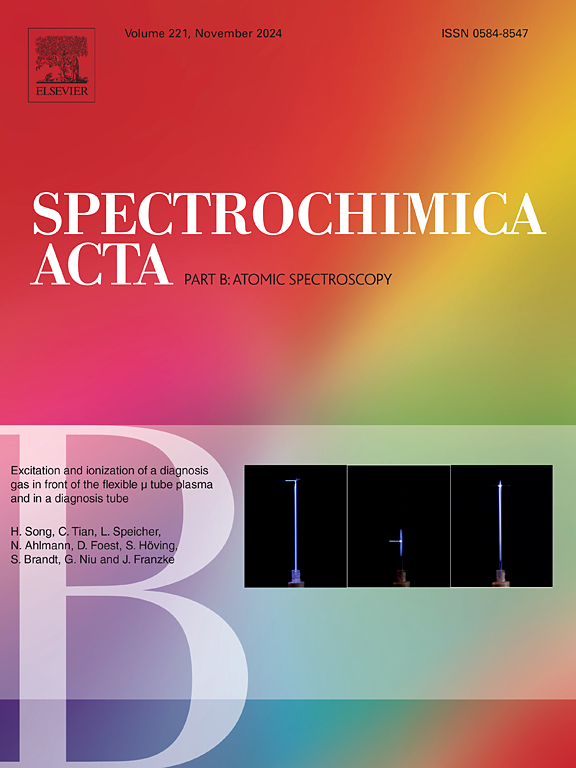Study of optically thin condition for quantification of trace quantity of boron in aqueous sample using LIBS assisted by acoustic levitation
IF 3.8
2区 化学
Q1 SPECTROSCOPY
引用次数: 0
Abstract
LIBS analysis of liquids has faced challenges such as splashing and weak signals due to laser energy absorption by numerous liquid molecules. The analysis of evaporable liquids has been improved using surface-assisted/enhanced methods; however, these approaches have disadvantages, such as undesired ablation of the substrate material and uneven analyte distribution during preconcentration on the substrate surface, also known as the coffee ring effect. To address these issues, a novel technique has been introduced, utilizing an acoustic levitator to suspend liquid droplets without contact with any material. During preconcentration, the water content of the droplet is evaporated using a CW laser, leaving behind the mineral residue for LIBS analysis. Quantifying boron is particularly challenging by the conventional LIBS technique in the standard UV-NIR spectral range due to the presence of only one detectable doublet at 249.7 nm, which is often subject to self-absorption. Optimization of the delay and gate times of the iCCD camera was performed using the branching ratio technique to evaluate the optically thin condition. A calibration curve was constructed by preparing solutions at different concentrations of H3BO3 in an aqueous solution and was represented as HBO2, the LOD was found to be 28.7 mg/L (ppm) of HBO2. Finally, trace amounts of boron in bottled mineral water were successfully determined as 34.7 mg/L of HBO2 with a 12 % error margin.

声悬浮辅助LIBS定量水样中微量硼的光学薄化条件研究
液体的LIBS分析面临着由于激光能量被大量液体分子吸收而产生的飞溅和微弱信号等挑战。使用表面辅助/增强方法改进了可蒸发液体的分析;然而,这些方法有缺点,如衬底材料的不期望烧蚀和衬底表面预浓缩过程中分析物分布不均匀,也称为咖啡环效应。为了解决这些问题,一种新技术被引入,利用声波悬浮器悬浮液滴而不与任何材料接触。在预浓缩过程中,使用连续波激光蒸发液滴的含水量,留下用于LIBS分析的矿物残留物。在标准紫外-近红外光谱范围内,由于在249.7 nm处只有一个可检测的双重态,通常受自吸收影响,传统的LIBS技术对硼的定量尤其具有挑战性。采用分支比技术对iCCD相机的延迟时间和栅极时间进行了优化,以评价其光薄状态。通过在水溶液中制备不同浓度的H3BO3溶液,建立了以HBO2表示的校准曲线,其LOD为28.7 mg/L (ppm)。最后,成功地测定了瓶装矿泉水中微量硼为34.7 mg/L HBO2,误差范围为12%。
本文章由计算机程序翻译,如有差异,请以英文原文为准。
求助全文
约1分钟内获得全文
求助全文
来源期刊
CiteScore
6.10
自引率
12.10%
发文量
173
审稿时长
81 days
期刊介绍:
Spectrochimica Acta Part B: Atomic Spectroscopy, is intended for the rapid publication of both original work and reviews in the following fields:
Atomic Emission (AES), Atomic Absorption (AAS) and Atomic Fluorescence (AFS) spectroscopy;
Mass Spectrometry (MS) for inorganic analysis covering Spark Source (SS-MS), Inductively Coupled Plasma (ICP-MS), Glow Discharge (GD-MS), and Secondary Ion Mass Spectrometry (SIMS).
Laser induced atomic spectroscopy for inorganic analysis, including non-linear optical laser spectroscopy, covering Laser Enhanced Ionization (LEI), Laser Induced Fluorescence (LIF), Resonance Ionization Spectroscopy (RIS) and Resonance Ionization Mass Spectrometry (RIMS); Laser Induced Breakdown Spectroscopy (LIBS); Cavity Ringdown Spectroscopy (CRDS), Laser Ablation Inductively Coupled Plasma Atomic Emission Spectroscopy (LA-ICP-AES) and Laser Ablation Inductively Coupled Plasma Mass Spectrometry (LA-ICP-MS).
X-ray spectrometry, X-ray Optics and Microanalysis, including X-ray fluorescence spectrometry (XRF) and related techniques, in particular Total-reflection X-ray Fluorescence Spectrometry (TXRF), and Synchrotron Radiation-excited Total reflection XRF (SR-TXRF).
Manuscripts dealing with (i) fundamentals, (ii) methodology development, (iii)instrumentation, and (iv) applications, can be submitted for publication.

 求助内容:
求助内容: 应助结果提醒方式:
应助结果提醒方式:


